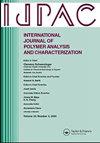银-氧化石墨烯纳米复合材料掺杂壳聚糖/PVA膜对酸性蓝324染料的水处理
IF 1.6
4区 工程技术
Q4 POLYMER SCIENCE
International Journal of Polymer Analysis and Characterization
Pub Date : 2025-10-03
DOI:10.1080/1023666X.2025.2504554
引用次数: 0
摘要
在过去的20年里,膜技术作为一种实用而有前途的水过滤方法受到了广泛的关注。本研究的目的是制备一种掺杂氧化石墨烯和银(GO/Ag)纳米复合材料的壳聚糖-聚乙烯醇膜,用于酸性蓝324染料的水处理。制备了氧化石墨烯/银纳米复合材料,并用TEM、DLS和紫外可见光谱对其进行了表征。制备了四种不同类型的膜;壳聚糖(Ch)、聚乙烯醇(PVA)、Ch-PVA和壳聚糖-PVA随氧化石墨烯/Ag的浓度下降。利用差示扫描量热法(DSC)、紫外光谱和傅里叶变换红外(FTIR)技术对制备的膜进行了表征。氧化石墨烯/Ag Ch-PVA膜热稳定,膜的熔融温度为337.66℃。将氧化石墨烯/银纳米复合材料掺杂到Ch-PVA基体中,在200-380 nm范围内的吸收值更高,支持分解染料可溶于水,并起到光催化剂的作用。在不同的pH值和初始染料浓度下,考察了染料在水中的浓度和膜的吸附能力。结果表明,与Ch-PVA、PVA和Ch膜相比,GO/Ag Ch-PVA膜对染料的吸收率分别提高了83.1%、69.5%和65.4%。此外,还发现所制备的膜在低pH水平下比碱性介质具有更高的染料去除效率。在pH为2时,GO/Ag Ch-PVA膜的染料吸收效率分别比PVA、Ch和Ch-PVA膜高11.47%、1.78%和14.84%。研究结果表明,该膜是一种有效的染料去除吸附剂。本文章由计算机程序翻译,如有差异,请以英文原文为准。
Silver-graphene oxide nanocomposite-doped chitosan/PVA membrane for water treatment of Acid Blue 324 dye
Membrane technology has garnered a lot of attention as a practical and promising approach to water filtration throughout the last 20 years. The goal of the current research was to create a chitosan-PVA membrane doped with graphene oxide and silver (GO/Ag) nanocomposite for water treatment of acid blue 324 dye. GO/Ag nanocomposite was prepared and characterized by TEM, DLS, and UV-Vis spectroscopy. Four types of membranes were prepared; chitosan (Ch), polyvinyl alcohol (PVA), Ch-PVA ,and chitosan–PVA dropped with GO/Ag. Differential scanning calorimetry (DSC), UV spectroscopy, and Fourier Transform Infrared (FTIR) techniques were used to characterize the fabricated membranes. GO/Ag Ch-PVA membranes are thermally stable, as the melting temperature of the membrane is 337.66 °C. Doping GO/Ag nanocomposite into the Ch-PVA matrix resulted in higher absorption values over the range 200–380 nm, supporting the break down dye soluble in water and acting as a photocatalyst. Dye concentrations in water and the membrane’s adsorption capacity were evaluated at different pH values and initial dye concentrations. The results indicated that compared to Ch-PVA, PVA, and Ch membranes, the GO/Ag Ch-PVA membrane absorbs the dye by 83.1%, 69.5%, and 65.4% more. Additionally, it was discovered that the produced membranes have a higher dye removal efficiency at low pH levels than the basic medium. At pH 2, the dye absorption efficiency of GO/Ag Ch-PVA is higher by 11.47%, 1.78%, and 14.84% when compared to PVA, Ch, and Ch-PVA membranes. Research findings suggested that this fabricated membrane could be an effective dye removal adsorbent.
求助全文
通过发布文献求助,成功后即可免费获取论文全文。
去求助
来源期刊
CiteScore
3.50
自引率
5.30%
发文量
37
审稿时长
1.6 months
期刊介绍:
The scope of the journal is to publish original contributions and reviews on studies, methodologies, instrumentation, and applications involving the analysis and characterization of polymers and polymeric-based materials, including synthetic polymers, blends, composites, fibers, coatings, supramolecular structures, polysaccharides, and biopolymers. The Journal will accept papers and review articles on the following topics and research areas involving fundamental and applied studies of polymer analysis and characterization:
Characterization and analysis of new and existing polymers and polymeric-based materials.
Design and evaluation of analytical instrumentation and physical testing equipment.
Determination of molecular weight, size, conformation, branching, cross-linking, chemical structure, and sequence distribution.
Using separation, spectroscopic, and scattering techniques.
Surface characterization of polymeric materials.
Measurement of solution and bulk properties and behavior of polymers.
Studies involving structure-property-processing relationships, and polymer aging.
Analysis of oligomeric materials.
Analysis of polymer additives and decomposition products.

 求助内容:
求助内容: 应助结果提醒方式:
应助结果提醒方式:


